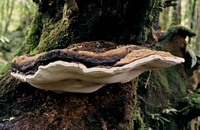|
 Ganoderma applanatum Ganoderma applanatum
SynonymsBoletus applanatus
Polyporus applanatus
Elfvingia applanata
Fomes applanatus
Images (click to enlarge)
Owner: Peter Buchanan |
Article: Gadgil, P.D. (in association with Dick, M.A.; Hood, I.A.; Pennycook, S.R.) (2005). Fungi on trees and shrubs in New Zealand. Fungi of New Zealand. Ngā Harore o Aotearoa 4: xi + 437 p. Hong Kong: Fungal Diversity Press.
Description: Type: Lignicolous Fungi; Description: Basidiomata perennial, solitary, hard, woody, attached by a broad lateral base. Pilei applanate, occasionally effused-reflexed, 50–320 mm broad, 20–110 mm thick. Pileus surface strongly concentrically sulcate, sometimes irregular and warty when old, greyish brown, frequently pale grey brown to light brown with a dusting of spores, margin sharp to rounded, cream in actively growing specimens, 1–8 mm wide. Pore surface even or sometimes distinctly pitted, at times even and pitted in different parts of the same fruit body, sterile margin 1–3 mm wide, concolorous with pore surface, white to pale yellow to light pink, brown when tubes not actively growing, pores in obvious strata and often with a thin (approximately 1 mm) band of context tissue separating the strata, 4–5 per mm. Context azonate or weakly zonate, dark reddish brown, up to 40 mm thick. Hyphal system trimitic. Basidiospores ovoid, 9–11 × 6–8 μm, punctate, appearing verruculose, pale brown.
Distribution: Distribution: Northland, Auckland, Coromandel, Waikato, Bay of Plenty, Taranaki, Taupo, Wanganui, Wellington, Gisborne, Hawkes Bay, Wairarapa, Nelson, Buller, Westland, Fiordland, Marlborough, Mid Canterbury, Otago Lakes, Central Otago, Dunedin, Stewart Island, Chatham Islands.; 1st Record: Berkeley (1855: as Polyporus igniarius).
|